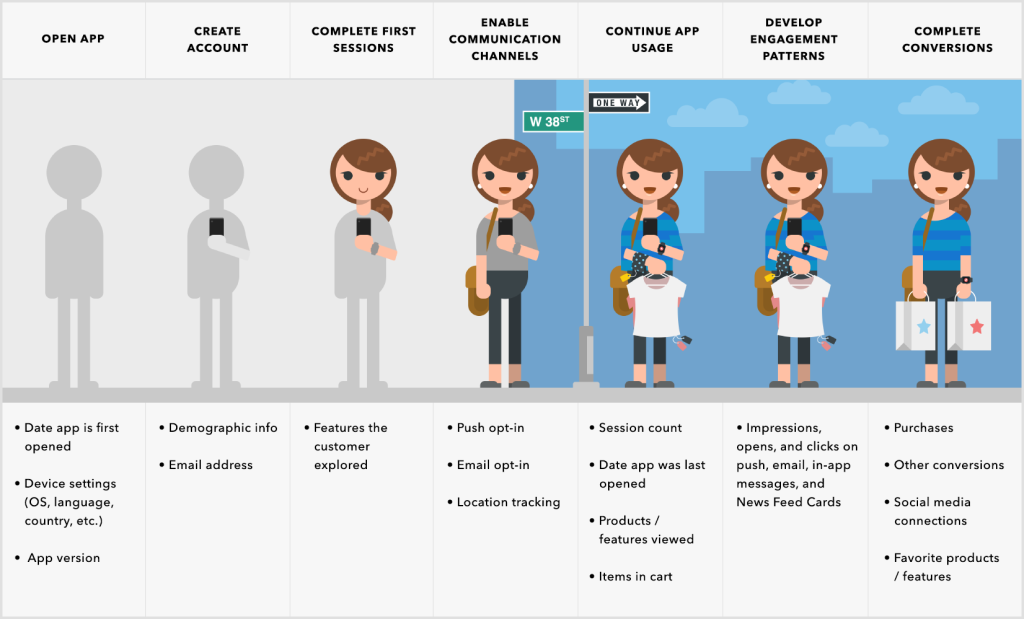User Profiles: The Foundation of Mobile Cross-Channel Marketing
Published on February 01, 2016/Last edited on February 01, 2016/7 min read


Todd Grennan
Content Production Principal, Content Marketing at BrazeToday’s mobile consumers are everywhere—they rely on a combination of web, app, email, social media, and in-person experiences to inform their brand and buying choices. As a result, reaching customers across a variety of messaging channels (also known as multi-channel messaging) has become more important than ever.
The trick is figuring out how to communicate meaningfully across these multiple channels. And that’s no easy task when you’re trying to present a unified brand to a large audience while simultaneously tailoring your marketing messages and experiences to individual customer preferences.
User profiles are one of the most important tools available for managing modern multi-channel marketing. These profiles are a treasure trove of organized personal data about the people who engage with your brand on each channel. You can use this detailed information about individual customers to build personalized marketing campaigns across multiple channels while still maintaining a consistent brand experience.
Tracking users in a cookie-less world
Cookies have long been a fundamental tool for gathering user information on the web. However, mobile apps don’t support cookies. Instead, app marketers use customer relationship management (CRM) platforms, such as Appboy’s product suite, to create a rich profile for each individual user. These platforms collect detailed data (much like browser-based cookies) to help you craft effective marketing campaigns. CRM platforms are built around the all-important user profile.
How user profiles work
Mobile user profiles are created the moment a customer opens your app and are continuously updated as the customer interacts with your brand across in-app channels and functions (like messages and app features) and out-of-app channels (like email). Each interaction adds more information to the profile.

- Opening the app: When a customer opens an app, a user profile is created. The profile includes the date the app is first opened, the customer’s language and region, and the app version. At this point the user hasn’t had to enter any information about themselves—all of this information is collected automatically.
- Creating an account: When a user creates an account on your app, their user profile is updated with demographic information such as age and gender, contact information such as an email address, personal information such as their name, and whatever else you require to create an account.
- Completing the first sessions: Once an individual starts using the app, you can track the features and content they explore. These usage patterns will help you determine whether your onboarding campaigns are doing a good job of introducing users to your most important features and leading them toward conversions. You can also use this data for personalized campaigns down the line. For example, you can send users campaigns highlighting new information on topics they’ve spent a lot of time exploring.
- Enabling communication channels: Users can be prompted to opt in to push notifications, your email subscription list, and location services. That gives you even more information about their demographic profile and interactions with your brand. It also gives you more channels through which you can reach each customer.
- Continuing app usage: User profiles will continue to track data on the number of sessions a user has on your app, the last time a customer opened the app, and the products and features they viewed or used.
- Developing engagement patterns: User profiles will track engagements with your marketing campaigns, such as push notification opens, email opens and clicks, in-app message impressions and clicks, and News Feed views and clicks.
- Completing conversions: Of course, user profiles will collect data for purchases or other conversions. They can also be used to track social media connections and a user’s favorite products or features.
The benefits of user profiles
On a broad level, knowing your customers and their goals is essential for building your business. Successful companies arecustomer-centric—building their marketing campaigns around their customers’ needs. User profiles provide a unique opportunity to really get to know your customers. Marketers can take that information and use it tobuild and deploy segmented campaigns that take into account personal preferences, habits, and past actions to deliver the most relevant experience possible—the experience most likely to end in a conversion.
User profiles can be used to:
- Build a unified brand experience: Take advantage of the data in your user profiles to create cohesive campaigns that address your customers across every platform, ensuring that your brand delivers a unified experience. Most customers don’t know or care about brands’ marketing, sales, or customer service silos—they want consistency wherever they interact.
- Reach your audience where and when it makes the most sense: Marketing is about both intelligently targeting your current customers, as well as reaching out to new ones—the key is to make sure you’re catching theright audience at the right time. For example, mobile marketing automation (MMA) services can be used to send relevant push notifications to customers only in a specific area—like telling your customers who just got hit by a big winter storm that deliveries may be delayed, but you’ll give them 10% off their next order to help apologize for the inconvenience. They can also use your user profile data to send messages when individuals are most likely to engage, maximizing your ROI.
- Build ongoing campaigns to target a wide range of marketing opportunities: With detailed user profiles, you can build campaigns to send marketing messages that are relevant to your users. Has a shopper abandoned their cart? You can remind them about your free shipping options to encourage them to come back. Do users who add friends in your app end up becoming your power users? Create a campaign that encourages new users to add friends.
- Build trust through value: Nobody likes spam, but customers happily receive brand marketing that helps them. By gathering the correct data to properly segment your target market, you can find ways to distribute coordinated communications that are driven by the customers’ goals and needs. That’s how you get deeper engagement.
How to get the most out of user profiles
Of course, even very basic user profiles can generate a lot of data. How do you find what’s useful in all of that?
Your brand will probably never use all of the information that’s possible to gather for user profiles—not all data points are relevant to every brand. To weed out the important bits, you’ll need to align your specific business goals with the relevant customer data. That way you can set up your various channels to collect the right demographic and behavioral data. If you’re looking to connect with teenagers in Mississippi, for example, you’ll need to make sure you have access to that age and location information. CRM services can help marketers decide which data to collect, including basic characteristics (i.e. gender, age, city, country, language, etc). Then, you’ll need to make sure your marketers and developers are on the same page in order to get the information you need from your visitors on each channel.
Once you’ve identified and collected the information you need, you can use it to shape your marketing efforts for each segment. For example, if you find that you have a large number of users who visit your app but don’t convert, you can target them with more information or more incentives.
Of course, you can never lose sight of your customer-centric model. Put yourself in your customers’ (and potential customers’) shoes. Make sure your messages are appropriate and not overbearing—people can become uncomfortable with marketing efforts that suggest a brand knows a lot about them personally, especially if they don’t remember sharing the information being referenced.
The skinny…
As with every other aspect of your business, it all boils down to meeting your customers’ needs. User profile data can help you understand who your customers are and, thus, how to speak to them. Those same profiles help to keep your brand consistent and reliable across every platform while simultaneously allowing you to provide targeted, personalized marketing campaigns that will provide value and delight your customers.
Releated Content
View the Blog
The new inbox reality: How iOS changes are reshaping email marketing

Aparna Prasad

Experience optimization: Turning data insights into better journeys

Team Braze

December 2025 Bonfire Marketer of the Month: Jagex’s Emma Oliver
